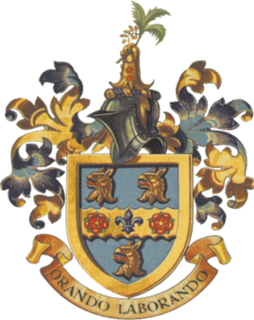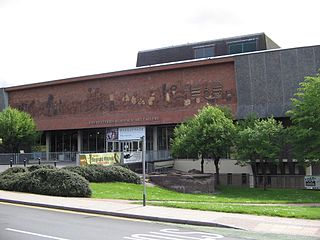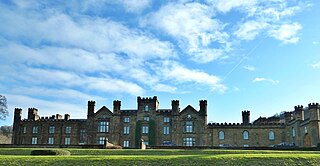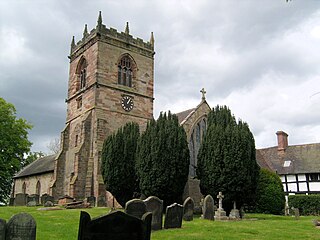Related Research Articles

Richard III was King of England and Lord of Ireland from 26 June 1483 until his death in 1485. He was the last king of the House of York and the last of the Plantagenet dynasty. His defeat and death at the Battle of Bosworth Field, the last decisive battle of the Wars of the Roses, marked the end of the Middle Ages in England. He is the protagonist of Richard III, one of William Shakespeare's history/tragedy plays.

John Morton was an English prelate who served as the Archbishop of Canterbury from 1486 until his death and also Lord Chancellor of England from 1487. He was elevated to the cardinalate in 1493.

Edward IV was King of England from 4 March 1461 to 3 October 1470, then again from 11 April 1471 until his death in 1483. He was a central figure in the Wars of the Roses, a series of civil wars in England fought between the Yorkist and Lancastrian factions between 1455 and 1487.

Rugby School is a public school in Rugby, Warwickshire, England.

Southgate is a suburban area of North London, England in the London Borough of Enfield. It is located around 8 miles (13 km) north of Charing Cross. The name is derived from being the south gate to Enfield Chase.

Arnold is a market town and unparished area in the Borough of Gedling in the ceremonial county of Nottinghamshire in the East Midlands of England. It is situated to the north-east of Nottingham's city boundary. Arnold has the largest town centre in the Borough of Gedling and the most important town centre in the northeastern part of the conurbation of Greater Nottingham. Gedling Borough Council is headquartered in Arnold. Since 1968 Arnold has had a market, and the town used to have numerous factories associated with the hosiery industry. Nottinghamshire Police have been headquartered in Arnold since 1979. At the time of the 2011 United Kingdom census, Arnold had a population of 37,768.

Prince Edward County (PEC) is a municipality in southern Ontario, Canada. Its coastline on Lake Ontario’s northeastern shore is known for Sandbanks Provincial Park, which has sandy beaches and towering limestone cliffs. The Regent Theatre, a restored Edwardian opera house, sits at the heart of the town of Picton on the Bay of Quinte. Nearby Macaulay Heritage Park highlights local history through its 19th-century buildings. In 2016, Prince Edward County had a census population of 24,735. Prince Edward County is a city, single-tier municipality and a census division of the Canadian province of Ontario.

David Robert Somerset, 11th Duke of Beaufort GCC, known as David Somerset until 1984, was an English peer and major landowner.

Arnos Grove is an area of north London, England, within the London Borough of Enfield. It is centred 7.5 miles (12 km) north of Charing Cross. It is adjacent to New Southgate. The natural grove, larger than today, was for many centuries the largest woodland in the chapelry of Southgate in the parish of Edmonton. It became inter-related with Arnos Park when its owner was permitted to enclose much of its area through the widespread legal practice of inclosure of the common land to create the former park, the heart of which is now public parkland.
The Weld family may refer to an ancient English family, to their possible relations in New England, an extended family of "Boston Brahmins", or to their Irish or Antipodean relations. An early record of a Weld holding public office, is of the High Sheriff of London in 1352, William. In the 16th and 17th centuries people called Weld and living in Cheshire began to travel and to settle in the environs of London, in Shropshire, in Suffolk and thence in the American Colonies, and in Dorset. While the Welds of England had adopted Protestantism, the exception were all three sons of Sir John Weld of Edmonton who married into elite recusant families thus reverting, with their descendants, to Roman Catholicism. The noted Catholic Weld lineage unbroken till the new Millenium is that of Lulworth Castle in Dorset.

The Potteries Museum & Art Gallery is in Bethesda Street, Hanley, one of the six towns of Stoke-on-Trent in Staffordshire. Admission is free.

Brislington West is a council ward of the city of Bristol, England. It covers the western part of Brislington, together with Arnos Vale and Kensington Park.

Wilton Castle is an early 19th-century mansion, built on the site of a medieval castle, now converted into luxury residential apartments, situated at Wilton, in Redcar and Cleveland, North Yorkshire, England. It is a Grade II listed building.

Lapley Priory was a priory in Staffordshire, England. Founded at the very end of the Anglo-Saxon period, it was an alien priory, a satellite house of the Benedictine Abbey of Saint-Remi or Saint-Rémy at Reims in Northern France. After great fluctuations in fortune, resulting from changing relations between the rulers of England and France, it was finally dissolved in 1415 and its assets transferred to the collegiate church at Tong, Shropshire.
Sir Nicholas Haute, of Wadden Hall (Wadenhall) in Petham and Waltham, with manors extending into Lower Hardres, Elmsted and Bishopsbourne, in the county of Kent, was an English knight, landowner and politician.
John Arnold, widely known as John Arnold of Monmouthshire, was a Welsh Protestant politician and Whig MP. He was one of the most prominent people in Monmouthshire in the late 17th century. A stark anti-Catholic, he was a notable figure during the Popish plot and the suppression of Catholicism in the country. Arnold represented the constituencies around Monmouth and Southwark in Parliament in the 1680s and 1690s. His strong anti-Catholic beliefs and insurgences against Catholic priests made him an unpopular and controversial figure amongst his peers and in his native Monmouthshire. In his later years his behaviour became increasingly eccentric, and he was widely believed to have faked an attempt on his own life. Amongst his associates were Titus Oates and Anthony Ashley Cooper, 1st Earl of Shaftesbury.
John de Echingham S.T.D. was an English medieval Chancellor of the University of Oxford, who held that dignity for three consecutive years.

Arnos Grove, originally known as Arnolds, is a grade II* listed house in Cannon Hill, Southgate, London.

Minchington Hall, or Mincington Hall, or Minchenden House, was a country house and estate in Southgate, then in the county of Middlesex in England, and now in Greater London. It was on Southgate Green and the south side of Waterfall Road, and adjoined Arnolds slightly further east, which was originally less significant than Minchington. The estate was merged into Arnos Grove in 1853 and the house demolished.

Arno Press was a Manhattan-based publishing house founded by Arnold Zohn in 1963, specializing in reprinting rare and long out-of-print materials.
References
- ↑ Mason, Tom. (1947) The Story of Southgate. Enfield: Meyers Brooks. p. 3.
- ↑ Edmonton: Other estates. British History Online. Retrieved 26 August 2017.
- ↑ London and Middlesex Fines: Edward III. British History Online. Retrieved 26 August 2017.